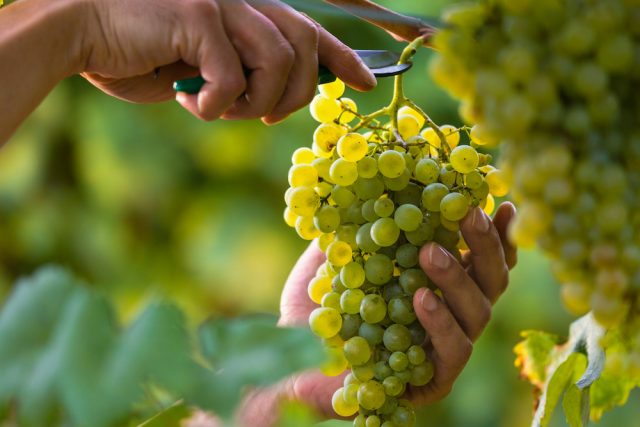What does California’s grape oversupply mean for the trade?
There are a record number of premium grapes being offered on the cheap in California. But what does this mean for the wine trade? Kathleen Willcox investigates.

If you’re shopping for haute couture grapes, this is your season to score big, especially in California! Anyone?
“You see these incredible steals out there in Wine Country Classified and on WineBusiness.com,” says Rachel Martin, winemaker and co-founder of Oceano Wines in
San Luis Obispo.
“I was recently in a shipping location sending out samples and the guy behind the counter asked me if I was in the market for Coombsville Cab. He was offering his family’s grapes for $7,500 a ton, a price I’m sure he’s reduced since then, because the winemaker who was contracted to take them backed out. I was actually tempted for a second, but then I realized, ‘wait. I don’t even make Cab! I’d have to launch a whole new SKU. No way.’”
Anecdotally, Martin says the vibe in wine country is very much “should I? nope,” when it comes to the record number of premium grapes being offered at cut-rate prices.
“You can feel the desperation, and there are some great opportunities, but it just feels too risky,” Martin says.
The number of grape listings on the WineBusiness Bulk Wine and Grape Board in July were up 164% year-over-year, and reached an all-time record of 750 posts. So far this year, postings hover around 3,000. Last year, the total tally was 2,478.
All of this comes amid other dire reports from wine country: tasting room traffic in Sonoma County and the Napa Valley were done 5.9% and 5.3% respectively, with sales drops of 2.9% and 4.2% reported year-to-date, according to Benchmark.
Critically acclaimed and wine afficionado beloved and respected wineries and tasting rooms like Carlisle Winery, Brendel Wines, Tarpon Cellars, Twisted Oak Winery and Sbragia Family Vineyards have closed up shop this year. Major conglomerates are hurting too. Vintage Wine Estates filed for bankruptcy two months ago, and in the process, has agreed to sell most of its California wineries. All told, Vintage produced more than 2 million cases of wine per year, and its bankruptcy filing cited more than $400 million in liabilities.
The situation is equally dire in other major wine-growing regions: Bordeaux is ripping out 23,500 acres of vineyards, Australia is removing 30,000 acres and Chile continues to remove acreage amid the global wine glut.
“What we are seeing in the wine industry is a perfect storm,” says Natalie Collins, president of the California Association of Winegrape Growers, which represents about half of the state’s total crush on any given year. “It looks like one issue—an oversupply—but really, it’s several issues coming together, including a hangover from COVID when importers, distributors and retailers purchased too much wine and they are still trying to sell through those stocks. Plus, there has been a shift in consumption, increased competition from other categories of alcohol and economic constraints.”
Whether or not this issue represents an existential crisis for the wine industry or not very much depends on perspective.
This is a much-needed rebalancing
Jeff Bitter, president of the Allied Grape Growers, which represents $100 million worth of sales per year, points out that a business that takes a product between three to five years to move from crop to shelf, requires extreme long-term vision for success.
“It’s not about a single year,” Bitter says. “But this year, things are not good. We’re seeing multiple growers not even making enough to cover the costs of doing business, and growers not being able to move their grapes at all and opting to not even pick.”
Overall, Bitter says this year will be a historically bad year for growers, with many not only not breaking even, but seeing a devastating loss. He says he has been pushing for vineyard removal for years.
Earlier this year, Bitter did advise growers to pull out 50,000 acres of vineyard to rebalance supply and demand. Vineyard removal is painful, but he says it is necessary for the industry’s health moving forward if prices are going to stabilize and demand is going to return to normal.
“The only reason I’m always talking about ripping out vineyards, which I know sounds terrible, is that it’s the fastest way to get us back in balance,” he says. “And the truth is, we need to rip out even more than I forecast earlier this year. If we want to be healthy moving forward, we’re going to have to add 10s of thousands of acres to my original estimate.”
Already, growers have removed 18,000 acres.
There are a few obvious areas of weakness and strength, Bitter says. Certain varieties, like Zinfandel, Merlot and Syrah, are tough sells and generally end up in blends. Sauvignon Blanc, Cabernet Sauvignon and Pinot Noir, are performing fairly well. Anything below $10 is in trouble, and Lodi, Delta and the Northern California Interior are also languishing.
But Bitter is overall bullish on California’s future—if growers and producers opt to rebalance and wait it out.
“We had very small crushes for three years in a row between 2020 and 2022 due to smoke taint and short crops,” he says. “The high prices the grapes received and the demand during COVID sent false signals about the health of the market. It felt so much better than it was in reality, which has why the last few years have been so brutal.”
The inventory bubble, coupled with crop yield blips and weakening demand for wine make the current cycle feel like an emergency when it really isn’t, Bitter says.
Others agree that the perception of the current and future state of wine is slightly different than the reality.
“The best news we have amid all of the bad news is that we’ve been here before,” says Rob Mondavi Jr., fourth generation Napa Valley vintner, founder of Folio Fine Wine Partners and head of winemaking at Michael Mondavi Family Estate. “We’ve been through Prohibition, world wars, multiple economic crises and several times when it felt like the next generation was never going to evolve beyond sweet fizzy drinks and really start embracing the regal elegance of wine.”
While Mondavi believes the wine industry will emerge intact, he does believe that there are a few key challenges contributing to the sales and oversupply issues that the California wine industry has to overcome, either directly or indirectly, before it can move forward.
“I think a few things are already happening, and need to continue to happen,” Mondavi says. “The first is that you’re seeing a lot of smaller brands started as trophies by successful business people who love wine and had romantic ideas about the industry. Seeing all of the smaller brands shutting down and selling may feel like a ‘the sky is falling’ moment, but in fact it is a reset. Not everyone has the long-term view, and that’s what you need to succeed in this business over multiple generations.”
Partner Content
There’s also the issue of oversupply, which Mondavi sees as a function of inappropriate upselling.
“There are a lot of sub-AVAs within Napa, to pick one example, that are using grapes from Valley bottomland then trying to sell it for $200 a bottle,” he says. “That needs to stop because it’s not good for anyone.”
This is an industry wakeup call
But other pros say that the glut of available grapes on the market signals more than they’re willing to admit.
“It breaks my heart to see what’s happening out there,” Martin says. “There are so many companies failing right now that were built on dreams. I am the child of wine producers, and I love making wine.”
She says the only way she prevented substantial issues was by seeing the writing on the wall years ago.
“I started thinking about the shrinking market, and changed course,” Martin explains.
Martin says that because distribution channels are “completely clogged,” she shifted most serious sales efforts to direct to consumer (DTC). And more to the point, she started producing a line of wines, Oceano Zero, without alcohol.
“I get immense joy from making wine, and doing it without alcohol not only allows me to do what I love, it allows me to actually sell wine,” she says. “It also, for the first time in a long time, makes me feel good about what I do. I feel like I’m helping people find a premium wine without alcohol. The market is growing so much, and it’s not only people who aren’t drinking at all who are buying my wine.”
Sales of non-alcoholic wine are projected to grow at a rate of 7.9% through 2030, according to Grand View Research. And as Martin noted, 78% percent of people who buy such wine consume alcohol, according to NielsenIQ.
“Ironically, my non-alcoholic wine has actually driven sales of my regular wine,” she says. “I now have new customers for both wines, but they got to me through my non-alcoholic wine. I actually haven’t bottled a new wine with alcohol since 2022, and I’m currently trying to sell through that inventory.”
But the non-alcoholic line is not only selling out, it’s growing. Martin recently introduced a Syrah, which joined her Pinot Noir and Chardonnay.
Looking forward
One thing everyone can agree on is that there are a number of ways for the wine industry—growers, producers and the many businesses that rely on them—to stride forth confidently and successfully into the future.
“I think growers should be reaching out to producers of non-alcoholic wine,” Martin says. “That’s the one category of wine that is growing well, and good wine requires good grapes because it all has to be made into wine in the first place before the alcohol gets removed.”
Others, meanwhile, think that the way the industry markets itself to the public needs to change, pronto.
“The reality is we don’t have a unified group for domestic or California wine with a powerful marketing arm,” Collins says. “There are a lot of discussions happening behind the scenes right now, and I think something will come together soon. There’s a lot to talk about and promote that is very positive, and one of our main problems right now is that we don’t have a unified, powerful voice pushing for the industry as a whole.”
There’s also a way to highlight wine’s wholesome, healthy side amid declining consumption and increased alarm over alcohol’s health consequences.
“The industry needs to address the anti-alcohol movement on several fronts,” says Bitter.
“Because wine is about so much more than alcohol. We have to tell the story behind wine.
We also have to highlight the overall wholesomeness of wine, which unlike a lot of other forms of alcohol, isn’t mass-produced and is pretty pure. It’s essentially grapes and yeast.”
There’s a lot more than just grapes and yeast at stake.
The wine industry in California alone generates around $88.12 billion in economic activity and supports 513,738 jobs, according to an analysis from WineAmerica.
Winemaking touches almost every sector of life in California, making its success feel like a matter of economic survival for the state, which also happens to be the largest sub-national economy in the world.
Success in wine is, as Mondavi says, a long game.
There are a lot of theories on how significant the current losses are, and how it should be won. But one thing is clear: no one can sit this one out.
Related news
Readying Robert Mondavi Winery for a new generation





Good article. I’d like to see more discussion regarding the enormous imbalance of trade in the world wine market. We would not be endangering hundreds of thousands of American jobs if we were to impose a trade embargo that insured that U.S. imports of foreign wines had to match exports to those same countries.
Mr. Mondavi’s comment that we need to “really start embracing the regal elegance of wine.”, is part of the problem. Wine should not be thought of as a regal product, but one that can enhance everyone’s culinary and social lives.
Best and most realistic report I’ve read. I’ve been saying this very thing for YEARS, not months and was ignored because nobody likes bad news. But, the handwriting has been on the wall since before the pandemic. Most of the people in the wine business are hobbyists, not business people. I don’t feel sorry for any of them. They created their own mess with over production and insane advertising that talks AT people not to them. The millennials don’t like b***shit, and the wine business is nothing but!
You think California wine industry has an excess of grapes…look at Washington State and Southern Oregon proportionally they are in bigger trouble.
Absolutely spot on!